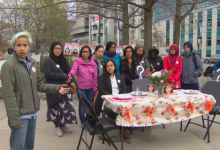What will become of Toronto’s Chinatown?
It was once a fixture of Toronto’s Chinatown neighbourhood, complete with a signature bright yellow facade and emerald green roof, guarded by two stone-carved lions.
Now just only a single lion remains, marred by graffiti, a “for lease” sign sitting in the window behind it.
Today, the site of the former Hsin Kuang Centre, home to the Bright Pearl restaurant for over a decade, sits largely empty — replaced by a minimalist, if unremarkable, four-storey office building. Or, as Amy Lam puts it: “a grey, modernist cube situation.”
Lam, a Toronto artist, is part of an initiative called Chinatowns Coast-to-Coast Fight Against Displacement. The coalition of grassroots organizers is pushing back against commercially-driven gentrification that they believe threatens the character of Chinatowns in cities across North America.
Over the past week, the group has organized demonstrations in Chinatowns in Los Angeles, San Francisco, New York, Montreal, Toronto and other major cities to call attention to the rising price of rent that they say is driving out decades-old family businesses and community spaces, giving way instead to luxury real-estate developments.
‘Replacing the things that make Chinatown Chinatown’
“Community is one thing that we lose when gentrification happens,” says Florence Yee, one of the operators of a new Chinatown-based arts-space called TeaBase that helped organized a demonstration in Toronto’s Chinatown over the weekend.
“If you replace our local grocery stores and the small mom and pop shops with office buildings, you’re replacing the things that make Chinatown Chinatown.”
That’s a sentiment that retired librarian and Chinatown historian Arlene Chan knows well.
Chan’s late mother, Jean Lumb, who arrived in Toronto from British Columbia in 1935, was one of the founding members of Toronto’s “Save Chinatown” campaign. Though Chinatown then wasn’t where we know it to be today.
At the time, Toronto’s Chinatown was about where city hall stands now. But eventually about two-thirds of that land was expropriated for the municipal government building, prompting Lumb and others to try to save the remaining third.
Many others in the Chinese community relocated to Spadina Avenue at Dundas Street, where rent was more affordable. And a third Chinatown had sprung up in the Broadview and Gerrard area, where prices were even lower.
Today, that first Chinatown is pretty well gone, says Chan. And the Broadview iteration, once home to about 30 Chinese restaurants, now has less than a handful.
Spadina Avenue is now the last remaining snapshot of the Chinese community’s earliest days in Toronto. And the history isn’t confined to the buildings themselves.
“It’s thriving, it’s busy … On the weekends, the grandmothers that make their own sticky rice dumplings are selling them on the corner with the vegetables that they grow in their vegetable gardens.”
A place of change?
That in part is why Chan is optimistic.
Chinatown, she says, has always been a place of change. Most notably, there was the SARS outbreak in 2003, when an elderly woman who had travelled to Hong Kong died of the deadly virus in Toronto. Fears about the illness “almost wiped out Chinatown,” says Chan.
Then there were plans for a Spadina Expressway that would have run right through the area.
And of course 346 Spadina Avenue wasn’t always the site of the beloved Bright Pearl. Before it was sold to a Taiwanese restaurateur in 1971, the building was home to the historic Labour Lyceum, a hub for Jewish textile workers and activism, where in 1937, famed American labour organizer Emma Goldman once spoke.
Even the population of Chinatown has changed over the years: around the time of the Second World War it was largely Cantonese-speakers from Guandong province, then there was the influx from Hong Kong, and later immigrants from China.
“So you could see the influence of the newer Chinese immigrants in Chinatown, we have these hand-pulled noodles and the immigrants coming from Taiwan brought us bubble tea,” she says.
Still, she says she applauds young people like Lam and Yee who are organizing to make sure the area doesn’t disappear.
“My hats off to the young people who are being vigilant and watching to make sure that what has happened to other communities doesn’t happen to our Chinatown.”
‘Still a good deal’
But while Lam and Yee are concerned about the effect of gentrification in the area, Tonny Loui, chair of the Chinatown BIA, isn’t worried.
“I think gentrification is a good thing because new shops are coming in. And as you know, the population has grown older and at a lot of the earlier businesses, the people are retiring so we need some new ideas and new operators,” he says.
Besides, he says, whereas Chinatown might have once been the singular hub for Chinese groceries and community events in Toronto, today there are thriving hubs of Chinese-owned business all over the Greater Toronto Area in places like Markham, Richmond Hill and Scarborough.
And while several of the newer businesses in the area are Chinese-owned, Yee worries their concerns are less about growing the existing relationships and communities in the area, and more about catering to, say, the significant international student body at the nearby University of Toronto.
“Usually more affluent people who come in … are not necessarily interested in the history of this space and the people who are already here, rather instead bringing a different, more affluent student business to Chinatown,” she says.
Chinatown, she says “is not only an important place for housing, but also culturally important as a place where people find each other, and find community and find ways to keep their roots, their family and their heritage alive.”
For Chan, whose roots in the community run deep, it’s impossible to ignore that the face of Chinatown is changing. The lone lion outside the vacant Metropolitan Commercial office space is a “disrespectful” reminder of that, she says.
But in order for the area to survive, she says, it will have to attract new people.
“Yes change is coming,” she says. “But Chinatown from day one has always been changing … The flavour of it will change, but Chinatown will still be there.”








Redes Sociais - Comentários